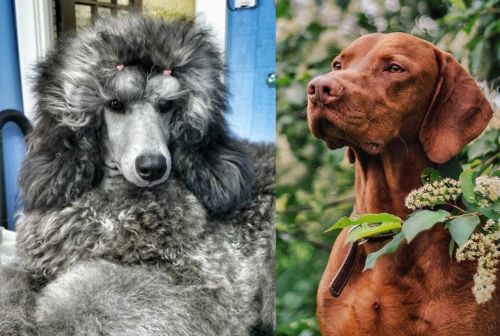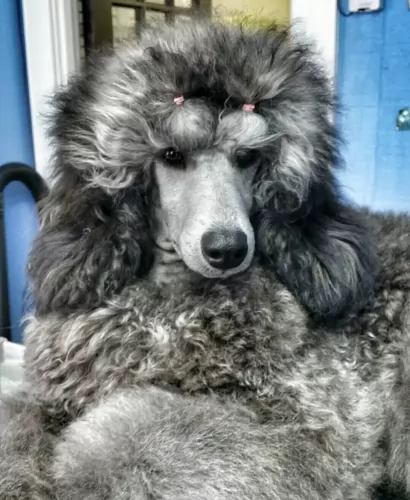 MyDogBreeds
MyDogBreeds Standard Poodle is originated from Germany but Vizsla is originated from Hungary. Standard Poodle may grow 12 cm / 5 inches higher than Vizsla. Both Standard Poodle and Vizsla are having almost same weight. Standard Poodle may live 5 years more than Vizsla. Both Standard Poodle and Vizsla has almost same litter size. Standard Poodle requires Moderate maintenance. But Vizsla requires Low maintenance
Standard Poodle is originated from Germany but Vizsla is originated from Hungary. Standard Poodle may grow 12 cm / 5 inches higher than Vizsla. Both Standard Poodle and Vizsla are having almost same weight. Standard Poodle may live 5 years more than Vizsla. Both Standard Poodle and Vizsla has almost same litter size. Standard Poodle requires Moderate maintenance. But Vizsla requires Low maintenance
 The Poodle is the national dog of France, and there they are known as the duck dog. The breed actually originated as a duck hunter in Germany. It was known as ‘Pudelin’ which means splashing in water.
The Poodle is the national dog of France, and there they are known as the duck dog. The breed actually originated as a duck hunter in Germany. It was known as ‘Pudelin’ which means splashing in water.
The dog has always had a crisp, curly coat to protect it from the elements. It is classified as a non-sporting dog. Soon the French became aware of what a fine dog it was and it became sought after among the elite in France.
It has been known for at least 400 years. While it is still not sure precisely from which country it comes, the poodle is a descendant of the French Water Dog which is now extinct.
 The Hungarian Vizsla or Magyar Vizsla is a hunting dog developed in Hungry. It is the smallest of the pointer-retriever type breeds. They are loyal family dogs and hunt fowl and upland game. It was rare for a hunting dog to also be a companion and family dog, but the Vizsla is. The first time the Vizsla came to the attention of anyone outside its area was 1357 in a publication written for King Louis I of Hungary. They were kept mostly by barons and warlords and preserved without any interbreeding for centuries.
The Hungarian Vizsla or Magyar Vizsla is a hunting dog developed in Hungry. It is the smallest of the pointer-retriever type breeds. They are loyal family dogs and hunt fowl and upland game. It was rare for a hunting dog to also be a companion and family dog, but the Vizsla is. The first time the Vizsla came to the attention of anyone outside its area was 1357 in a publication written for King Louis I of Hungary. They were kept mostly by barons and warlords and preserved without any interbreeding for centuries.
Through all the occupations, revolutions and world wars, the Vizsla survived. Still there were some points in their history where they were almost extinct. In the 1800’s English Pointers and German Shorthaired Pointers almost replaced them. After World War II they were almost extinct again with only a dozen or so left in the country.
Breeders across Hungry brought them back again. They were also bred in Serbia, Slovakia, Austria and Romania. They came to the states after the war and quickly were embraced. The Vizsla Club of America was formed so that they could be recognized by the American Kennel Club. This happened in 1960 and the Vizsla quickly became a champion in several AKC specialties.
The Weimaraner, the German Shorthaired Pointers, the Wirehaired Vizsla and other pointers were developed from the Vizsla and then used to re-establish the breed following World War II.
 The Standard Poodle is a medium-sized dog that stands between 35 and 40cm in height and weighs between 20 - 27 kg. The coat of the standard poodle is curly and medium length and it comes in a range of different colors – black, brown, cream, apricot or white.
The Standard Poodle is a medium-sized dog that stands between 35 and 40cm in height and weighs between 20 - 27 kg. The coat of the standard poodle is curly and medium length and it comes in a range of different colors – black, brown, cream, apricot or white.
The ears are medium shaped and floppy and the tail is most times docked to half its length. The muzzle is fairly long and the eyes are brown and alert.
Standard Poodles are full of the joys of living and they are friendly, fun, playful dogs. They love playing games with the children and they make excellent family dogs.
He is quite feisty and stubborn and will require training and socialization. He is smart and is in fact, one of the most trainable of all the dog breeds.
They can adapt to life in the city or the countryside but he will need to be exercised wherever he is. The Standard Poodle isn’t aggressive but he can still make a good watchdog.
 The golden/rust colored Vizsla is easily distinguished from other breed. They are a medium sixed pointer with a lean frame and light on their feet. They have long ears that are silky to the touch and well defined muscular structure. Their nose is a red color blending in with their coat color. Their eyes and nails also blend in with the color of the coat.
The golden/rust colored Vizsla is easily distinguished from other breed. They are a medium sixed pointer with a lean frame and light on their feet. They have long ears that are silky to the touch and well defined muscular structure. Their nose is a red color blending in with their coat color. Their eyes and nails also blend in with the color of the coat.
For the most part they are some shade of golden-rust, but today there are also some solid rust dogs as well. Officially the coat can be russet gold, copper-brown, or dark sandy gold. It cannot be mahogany red or pale yellow. The coat is dense, smooth, short and without an undercoat. They have docked tails as well.
 Poodles are clever, easy to train and capable of living well in the city or in the countryside.
Poodles are clever, easy to train and capable of living well in the city or in the countryside.
They’re adaptable dogs too which makes them excellent family pets. They’re active and social so when you bring one into your home, you’re going to know he is there.
He wants to be involved in every aspect of your life, bonding with all members of the family, loving to spend time with each one.
He is an all-rounder and will also be a great watchdog. Loving and loyal, the Standard Poodle is ready to become your ideal pet and companion.
 The Standard Poodle doesn’t have many health issues to worry about and he can live to a ripe old age of 15 or so if he is looked after well.
The Standard Poodle doesn’t have many health issues to worry about and he can live to a ripe old age of 15 or so if he is looked after well.
However, he can succumb to some of the common dog diseases there are – eye problems, skin allergies, bloat and ear infections.
Allergies in dogs can be caused by pollen, insects, food, and medicines. These allergies can all cause terrible itching, scratching, watery eyes, skin inflammation, and pain.
The ears, underarms, groin and around the eyes are often affected. It can make your pet most miserable. Your dog will have to get to the vet to relieve him of his discomfort and the vet will want a medical history to find out what is causing the problem.
 The Vizsla have few health issues but the ones they do have are quite serious. They include:
The Vizsla have few health issues but the ones they do have are quite serious. They include:
• Cancer (Mast cell, Lymphoma and Hemangiosarcoma) – as will most dogs it can be treated but is still likely to kill the dog.
• Hip dysplasia is rare, but cases have been noted. Can cause lameness and/or arthritis.
• Sebaceous adenitis – rare skin disease found more often in cats or birds than in dogs.
 The Standard Poodle will require regular brushing even though it is a low- or non-shedding breed. The curls can become matted. Some poodle owners choose to have their poodles professionally groomed and clipped.
The Standard Poodle will require regular brushing even though it is a low- or non-shedding breed. The curls can become matted. Some poodle owners choose to have their poodles professionally groomed and clipped.
The nails will need to be trimmed.
The teeth will also need to be checked if the dog will allow you to look inside his mouth. A bad, oozing tooth can cause all kinds of medical problems.
Because of the floppy ears, check inside the ears for dirt and wax buildup and signs of redness and a possible ear infection. If you don’t like to probe inside your dog’s ears or mouth, professional dog groomers will do this for you.
Your poodle is an active dog and he will need regular daily exercise. Chase him on the lawn, throw a ball for him, hide away from him and let him find you. He will also love daily walks.
Just like with any other dog, your Standard Poodle needs good, nutritional food to remain healthy. Some of the commercially manufactured dog foods you get are bad for a dog as they don’t have natural ingredients and are devoid of vitamins and minerals.
They’re certainly a convenient way to feed a dog, but try and go for the ones that are wholesome for your pet.
Home-made food such as boiled chicken, brown rice and vegetables is a good choice as it is healthy and won’t cause your dog to battle with digestive problems. Avoid spicy, exotic foods and things such as popcorn, onion, peanuts, and chocolate.
Make sure your Standard Poodle always has a bowl of fresh, cool water available.
 Feeding the puppy This is a very active dog and he need a high calorie diet as a puppy. Feed 4-5 cups in 3-4 smaller meals per day.
Feeding the puppy This is a very active dog and he need a high calorie diet as a puppy. Feed 4-5 cups in 3-4 smaller meals per day.
2.Feeding the adult Feed the adult high calorie food if you exercise her enough. Feed 3 cups of food twice a day.
4. Exercise They love to run but don’t’ overdo it until they are at least 18 to 24 months old. They stay very playful their entire lives and excel at AKC competitions. They are good at agility, field trials, scent work, obedience, conformation, dock diving, rally, lure coursing, track and barn hunt.